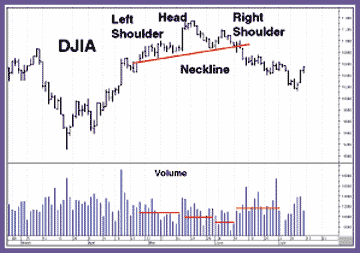CHARTING
An Old Reliable Pattern Ñ With A Twist
A New Slant On Head And Shoulders
by Charles E. Miller
Here's a detrending technique that will help you visualize slanted head and shoulder top patterns more clearly.
When the good old reliable head and shoulders (H&S) pattern emerges simultaneously in the Dow Jones Industrial Average (DJIA), the Nasdaq Composite (COMPX), and the S&P 500, it is not a good sign. The H&S indicates that a top has been reached, and that the market is due to head down. The display of the DJIA chart in Figure 1 is a near-perfect example of a classic head and shoulder pattern. H&S bottom formations are just as significant, but are subject to slightly different volume criteria.
THE HEAD AND SHOULDERS PATTERN
The H&S formation ideally consists of a series of three failed upward moves resulting from the dynamics of interactions between buyers and sellers. After an upward price trend, those who have ridden their stocks up will sell and take profits. This ends the uptrend forming the left shoulder. When the sellers are done selling and the buyers are satiated, volume contracts and prices fall.
At some point during this pullback, a group that had missed the original uptrend starts buying on what they perceive to be a technical reaction. The aggregate volume during the period defined by the head is usually lower than that of the left shoulder, and all those who bought or held at the top are faced with losses as the prices decline to the right of the head. Then a final and typically even smaller group of hopefuls starts buying again.
Those who bought higher during the formation are now behind and hoping to minimize their losses. They form a substantial overhead supply and ensure that with a little buying pressure, prices will rise slightly. When prices break downward through the neckline, serious selling pressure begins to predominate, driving prices further down. Now it's a case of everybody running for the exit, attempting to minimize his or her losses. Note the DIJA in Figure 1 has fallen on increased volume for the month following the downward break after completion of the right shoulder.

FIGURE 1: HEAD AND SHOULDERS PATTERN. The head and shoulders pattern is one of the more reliable predictors that show when a top has been reached.
If you filter out the higher-frequency variations using a moving average or (as in Figure 2) a linear regression indicator, you can see that a head and shoulders formation can be an excellent warning that a top has been hit and a decline is imminent.
The potential to take profits or at least minimize losses is obvious. The bad news is that you should never assume a valid H&S has formed until the price or index has broken down through the neckline. The consequence is that you've already lost the profit from the peak of the head back down to the neckline. Not only that, for a horizontal neckline, you've lost your entire trading time equal to the duration of the complete H&S formation. And third, the nicest-looking formation during development may simply fail to materialize as a valid H&S. This is why you should always confirm the pattern by the final break through the neckline, coupled with weak volume during the right shoulder.
The first objective of the H&S is that the decline reaches a level
below the neckline equal to the peak level of the head above it. That H&S
floor target was placed on the chart in Figure 3 when the index broke below
the neckline, and parallel to the neckline.
...Continued in the December 2001 issue of Technical Analysis of STOCKS & COMMODITIES
Excerpted from an article originally published in the December 2001 issue of Technical Analysis of STOCKS & COMMODITIES magazine. All rights reserved. © Copyright 2001, Technical Analysis, Inc.